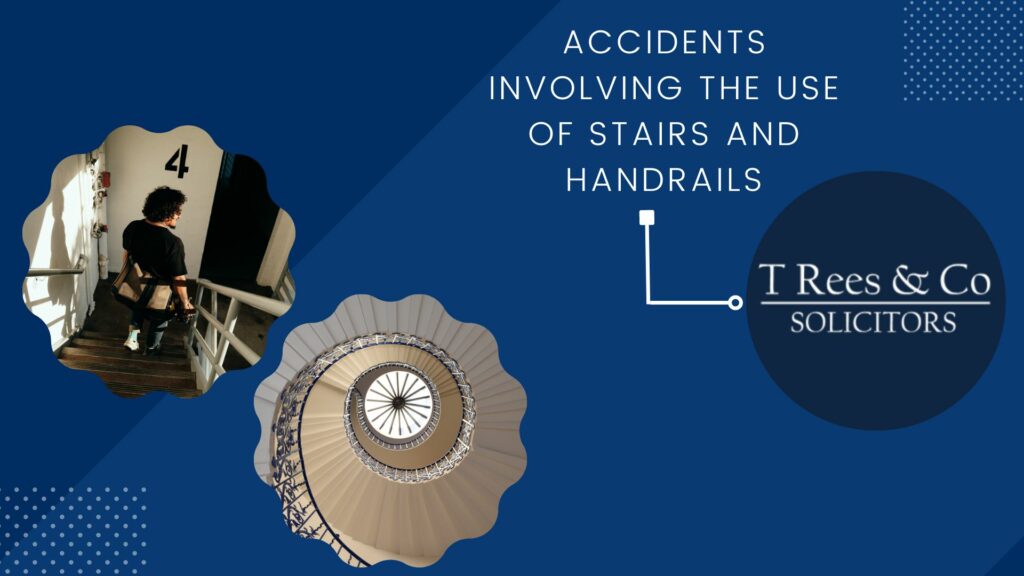Accidents and Handrails in Bexleyheath, London & South East of England
Personal Injury Compensation Claims relating to Accidents involving the use of stairs and handrails
During the course of the last few years I have dealt with a number of successful personal injury claims where claimants have been injured whilst using interior or exterior stairways where the steps were in good condition and the only cause of the accident was the absence of a suitable handrail. The Designs and Specifications for stairway handrails were first set out in the British Standards Part 1 1977 BS 5395 which recommended that every flight of stairs with an aggregate rise of more than 60cm should have a continuous handrail suitably fixed at a height of not less than 84cm. Handrails should be fitted to both sides of the stairway where the stairway is 1m or more in width. The handrail should be continuous and without abrupt termination or without severe changes in level or pitch. The British Standards were modified in 1994 when the requirements to fit handrails to both sides of the stairway also applied to spiral or helical stairs. The Regulations were further updated in 2000 with the requirement that handrails be securely fitted at a vertical height between 90cm and 100cm above the pitch line of the steps and be rigid and strong enough to provide adequate support for users and to provide comfortable grip without sharp height differences to provide adequate resistance to hand slippage. British Standards BS 5395 was again updated in 2010 and required handrails to be parallel to the pitch line over steps or horizontal over landings and to provide adequate assistance to prevent a slippage. Updated Regulations also required an entire hand to form a secure grip around the handrail rather than the less secure pinch grip which was used with two fingers. The new requirement required a mounting distance between the bottom of the handrail and the top of the stair balustrade of at least 5cm and required the handrails to be continuously grabbable down their entire length. The updated Standards also required the handrails to be free from any obstruction on the flight of stairs and that the handrail should have a perimeter of between 10 and 16cm, allowing most users to make a proper grip around the whole of the handrail. The requirement for handrails to be fitted to stairways is also set out in the Building Regulations 2010 Access to and Use of Buildings Approved Document M. The Building Regulations were subsequently updated in 2016 and provided guidance relating to the fitting of handrails to exterior flights of steps. The guidelines require every flight of steps with three or more risers to be fitted with a suitable handrail to one side. The grabbable handrail should be 85cm to 100cm above the pitch line of the flight of steps and extend for a minimum of 30cm beyond the top and bottom nosings of the flight of steps. The requirement to fit handrails to exterior stairways applies where the stairway forms the exterior part of the building or the steps are on a route giving access to the building or parking facilities.
The Building Regulations 2010 Approved document K protection from falling, collision and impact sets out regulations relating to the design of stairs. The Regulations relating to stairs for buildings other than dwellings (commercial buildings such as offices, shops and restaurants) states that the minimum headroom between landings and the top of a flight of steps and the ceiling should be at least two metres. Doors next to flight of stairs or landings should not open out to obstruct the width of the stairs or landings unless it is in use. If the flight of stairs is more than 2 metres in width, the flight of stairs should be fitted with a central handrail between both sides of the flight of steps. The maximum number of steps in each flight should not exceed 16 (this also applies to dwellings). If there are a total of 36 or more steps then there should be one change of direction between each of the flights of steps. Between each flight of steps there should be a landing (a flat area) which should have a depth from front to back of at least the equivalent of the smallest depth of the flight of steps and at least as wide as the flight of steps from side to side. The constructed length of each landing should be at least 1.2 metres (with no cupboards or furniture obstructing the landing). The regulations relating to the size of the steps is as follows. The minimum height of each step shall be 15cm and the maximum height 19cm. The minimum depth of the step from front to back shall be 25cm and the maximum depth shall be 40cm and each step should be fitted with suitable tread profile nosings.

Accidents and Handrails
Accidents involving the use of stairs and handrails
The Regulations relating to the size of the steps in dwellings described as private stairs are as follows. The minimum height for each step shall be 15cm and the maximum height 220cm. The minimum depth of the step from front to back shall be 22 cm and the maximum depth shall be 30cm. Steps in dwellings can have open risers ie a gap between the base of each step and the top of each step but the overlap treads should be at least 1.6cm and that the gap between each step should be no greater than 10cm. The minimum headroom between the landing areas and the top of each step should be 2 metres as with commercial stairways. The maximum number of steps within a continuous flight should be no more than 36 as with commercial stairways with landing areas between each flight of steps though in dwellings the landing areas do not have to be unobstructed.
In one successful claim, the claimant was injured whilst descending a flight of steps that was fitted with a handrail. The handrail was inadequate as it was designed for use by children at a children’s nursery and was set too low for adults to conveniently grip the handrail. In another successful claim, the flight of steps which provided access to a children’s play area, was not fitted with handrails. The children’s play area included various climbing frame structures and we were able to successfully argue that the same standard applied to climbing frame apparatus as to buildings. In another claim, the claimant was injured whilst on holiday and was walking from the lower patio area to a raised patio area which was accessed via three steps with no handrails. In all of the cases, the steps were in excellent condition and the claimant’s initial trip on the steps was an accident but became an actionable claim because the stairways were not fitted with handrails, therefore the claimants weren’t able to arrest their fall after initially stumbling, resulting in preventable injuries being sustained. In most handrail accidents there will be a deduction applied for contributory negligence in that the initial trip would not have arisen as a result of a defect in the design of the steps, or as a result of any damage to them.
T. Rees & Co based is a law firm established by T.D.Rees. Being based on the border of Kent & London allows us to work with claimants all over the South East, Kent, North Kent, Dartford, Bexley, Bexleyheath, Essex, Sussex, Surrey & London. For regular update please visit like and follow our social media.



